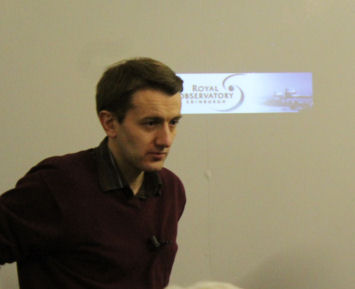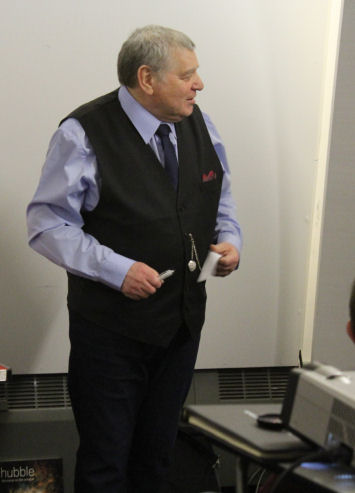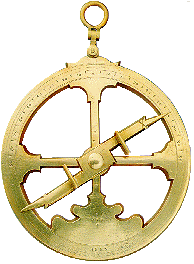12th February 2016 – William Taylor – Edinburgh University, "Mapping Our Universe, a Thousand Fibres at a Time"
William Taylor is a researcher based at the Royal Observatory Edinburgh, where he works as part of the Project Science group. This means that he spends the majority of his time working on projects to design new cameras and instruments for use with telescopes in different parts of the world. His role is to act as something of a bridge between the scientific and engineering communities, i.e. trading off what scientists want, with what engineers can actually build. Often the scientists are extremely demanding, which pushes technology to its extremes and keeps his job challenging! When he's not working on projects for new equipment he spends his time researching the evolution of massive stars, colossal objects, many, many times the size of our sun that live extremely fast-paced lives before dying in mighty supernovae. In their death throws, stars such as these eject heavy elements across the entire galaxy, so it is important to understand as much as we can about their hasty lives.”
William is an Instrument Scientist working on the Moons (Multi Object Optical and Near Infra Red Spectrograph) project, which is expected to be installed in Chile in a VLT (Very Large Telescope) in four years time.
MOONS is a third generation instrument designed to look at 1000 objects (actually 500 objects and 500 empty spaces!) at at time, using spectrographs to analyse them. With such analysis the rotational speed of massive stars and their wind structures can be measured and motion and direction can be mapped out.
MOONS is intended to be placed at the focal point of the VLT and, working in infra red, will use 1000 optical fibres to collect the information from as many individual objects as possible at a time. Currently the fibres are positioned by a robotic arm, a fibre at a time. This means a considerable time is taken in the positioning, but work is underway to design an array of 1000 robotic arms to align all fibres simultaneously.

Willaim stated "Astronomers are greedy: we always want more data. This desire pushes engineers to continually dream up ingenious ways to process the faint light we gather with telescopes. An excellent example of this process is MOONS, a new spectrograph for the Very Large Telescope in Chile that we are building at the Royal Observatory Edinburgh. This beast of an instrument will allow us to gather infra-red light from a thousand objects simultaneously.
Nothing quite like it currently exists, so in this talk I will try and explain how on earth we are going to build it, whilst also looking at what science we hope to do with it and whether we'll manage to satisfy those astronomers - at least for a little while!"
Infra red enables MOONS to look deeper into the heart of galaxies which are obscured by dust lanes and enable scientist to map the formation of galaxies as well as analyse the way merged galaxies evolve by measuring the movement of individual stars within them.
Because the instruments are designed to work in infra red the entire design must the be housed in a cryostat to reduce the temperature and avoid heat from the optics drowning out the heat from the incoming objects.
Thanks to William for an informative talk and insight into the problems and compromises in designing and building an amazing piece of kit (William’s own description).
Below is the complete talk by William. The recording is approximately one hour long.
Press the play button to hear online now or right click to download and save.

Following a tea break Tony showed a brief slideshow of lunar and planetary movie clips and photos which can be taken with a digital camera with a built in 83x zoom lens.
Jim Then reminded members that the following Friday was a planetarium night and if anyone could attend and possibly bring a telescope along, or in the event of inclement weather, other stuff of interest, it would be much appreciated.
Prior to our main speakers presentation, Andy Reminded members that the committee had agreed that the DAS social evening to celebrate its’ 60th year would take place at the Invercarse Hotel and all monies must be in, with completed forms by the 11th. of March. The date and further details of the event will be included on the website at a later date.
Tony looking rather dapper in his Christmas present from Edna - a tailor made waistcoat no less!!
William Taylor
